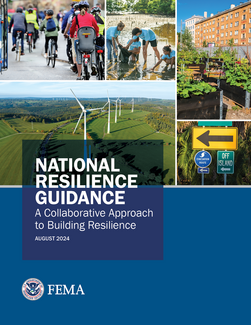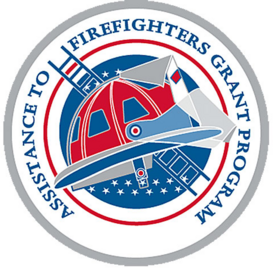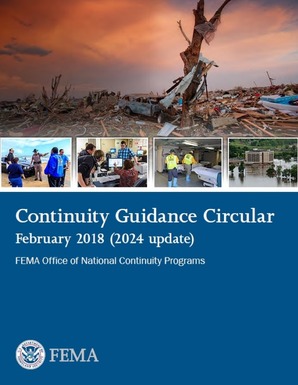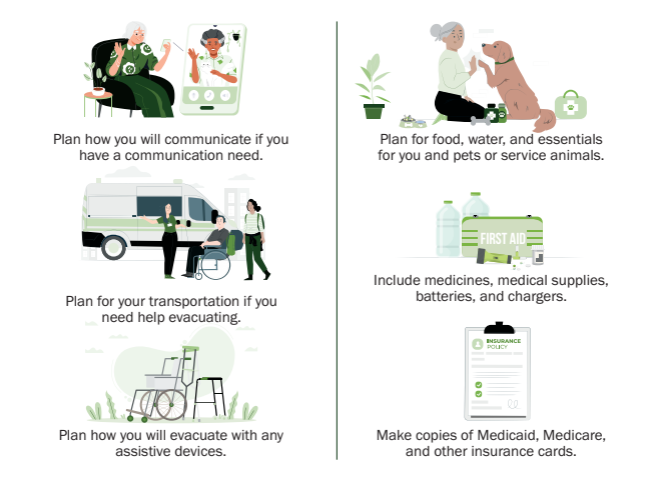|
.

FEMA is proud to announce the release of the National Resilience Guidance. The guidance offers a unifying vision of resilience and the principles and steps all communities and organizations can take to increase their resilience in every sector and discipline.
National resilience is a complex topic and building it requires whole community effort. This guidance will help everyone understand and fulfil their critical roles related to increasing national resilience. With the goal of increasing community and national resilience, the National Resilience Guidance:
- Promotes a common understanding of resilience.
- Emphasizes the critical relationship between chronic community stressors and acute shocks.
- Addresses the roles of individuals, organizations and all levels of government.
- Provides an actionable approach to resilience planning and implementation.
- Incorporates a community resilience maturity model that walks through concrete steps to build resilience.
FEMA will host a series of 60-minute webinar sessions in September and October to discuss the National Resilience Guidance and additional resources available to help new and experienced resilience practitioners improve their communities’ resilience.
To view the document and learn more about the webinar sessions, please visit the FEMA website at National Resilience Guidance | FEMA.gov.

Emergency management, as a practice, is constantly shifting to address the nation’s most pressing threats, risks and hazards, from climate change to cyber to pandemic preparedness. To better address these needs, FEMA’s Emergency Management Institute (EMI) is creating the National Disaster & Emergency Management University, or NDEMU, to help emergency managers build capacity today to meet the hazards of tomorrow.
By switching to a university model, NDEMU will offer comprehensive training across the entirety of an emergency manager’s career and close an identified gap in mid and advanced career professional development. The new NDEMU will be a three-school institution:
- The Emergency Management Institute (EMI) will continue as a brand within NDEMU to provide foundational training and development for early career emergency managers.
- The School of Disaster Leadership is for mid-and late-career emergency managers seeking professional development and continuing education. It will emphasize leadership development and include programs like the Vanguard Executive Crisis Leaders Fellowship and targeted certificate programs.
- The School of National Resilience will serve as a bridge between the emergency management profession and stakeholders within the field of emergency management. It will include deeper dives into disaster risk reduction for specific sectors such as health, planning, and climate change adaptation.
FEMA continues to provide excellent training through partners such as the Center for Domestic Preparedness, National Domestic Preparedness Consortium, Naval Postgraduate School and others. We expect NDEMU to help emergency management grow as a profession and ensure the pipeline of future talent has the depth of knowledge needed to face future hazards. Visit the Emergency Management Institute webpage to learn more about NDEMU.
The Department of Homeland Security announced final allocations of nearly $724 million in six Fiscal Year (FY) 2024 competitive preparedness grant programs. This includes $454.5 million in funding for the Nonprofit Security Grant Program, an increase of $149.5 million from FY2023, which will provide critical funding for faith-based groups and others to prevent and protect themselves from the heightened threat environment we face today.
These allocations, together with the more than $1.25 billion in non-competitive grant funding announced earlier this year, total almost $1.98 billion in FY2024 to help prepare our nation against threats and natural disasters.
The grant programs provide funding to state, local, Tribal Nation and territorial governments, nonprofit agencies and the private sector to build and sustain capabilities to prevent, protect against, respond to and recover from acts of terrorism and other disasters. The total amount for each grant program is set by Congress and the allocations are made by the Department through a competitive process.
Preparedness Grant Program Allocations for Fiscal Year 2024
The following grants are competitive, with allocations announced on Aug. 23:
-
Operation Stonegarden: Provides $81 million to enhance cooperation and coordination among state, local, Tribal Nation, territorial and federal law enforcement agencies to jointly enhance security along the United States land and water borders.
-
Tribal Homeland Security Grant Program: provides $13.5 million to eligible Tribal Nations to implement preparedness initiatives to help strengthen the nation against risk associated with potential terrorist attacks and other hazards.
-
Nonprofit Security Grant Program: Provides $454.5 million to support target hardening and other physical security enhancements for nonprofit organizations that are at high risk of a terrorist attack. This year, $227.25 million is provided to nonprofits in Urban Area Security Initiative-designated areas, and $227.25 million is provided to nonprofits outside those designated urban areas located in any state or territory.
-
Port Security Grant Program: Provides $90 million to help protect critical port infrastructure from terrorism, enhance maritime domain awareness, improve port-wide maritime security risk management and maintain or re-establish maritime security mitigation protocols that support port recovery and resiliency capabilities.
-
Transit Security Grant Program: Provides $83.7 million to owners and operators of public transit systems to protect critical surface transportation and the traveling public from acts of terrorism and to increase the resilience of transit infrastructure.
-
Intercity Bus Security Grant Program: Provides $1.8 million to owners and operators of intercity bus systems to protect surface transportation infrastructure and the traveling public from acts of terrorism and to increase the resilience of transit infrastructure. Eligible applicants receiving approval for funding requested only $1,214,968 of the $1.8 million made available this fiscal year.
The following non-competitive grants were announced earlier this year based on a number of factors:
-
State Homeland Security Program: Provides $373.5 million to support the implementation of risk-driven, capabilities-based state homeland security strategies to address capability targets. Awards are based on statutory minimums and relative risk as determined by DHS/FEMA’s risk methodology.
-
Urban Area Security Initiative: Provides $553.5 million to enhance regional preparedness and capabilities in 31 high-threat, high-density areas. Awards are based on relative risk as determined by the Department’s risk methodology.
-
Emergency Management Performance Grant: Provides $319.55 million to assist state, local, tribal and territorial emergency management agencies in obtaining the resources required to support the National Preparedness Goal’s associated mission areas and core capabilities to build a culture of preparedness.
-
Intercity Passenger Rail: Provides $9 million to Amtrak to protect critical surface transportation infrastructure and the traveling public from acts of terrorism and increase the resilience of the Amtrak rail system. Award made per congressional direction.
Further information on preparedness grant programs is available at DHS Grants and FEMA Grants.
.

FEMA awarded $330,559,121 from FY2023 Assistance to Firefighters Grants Program so far this year. The trio of grants provides critically needed resources to equip and train emergency personnel, enhances efficiencies and supports community resilience around the nation.
So far, 1,586 awards totaling $285,431,949 have been made in FY23 Assistance to Firefighters Grants (AFG). This funding helps meet the firefighting and emergency response needs of fire departments and non-affiliated emergency medical service organizations.
In the Staffing for Adequate Emergency Response Grants (SAFER) program, $36,416,089 has been distributed for FY23 funding. Awards have been made to 100 fire departments and volunteer firefighter interest organizations to help them increase or maintain the number of trained, "front line" firefighters available in their communities.
Also, a total of $8,711,083 has been awarded to 50 recipients of Fire Prevention and Safety Grants to support projects that enhance the safety of the public and firefighters from fire and related hazards.
FEMA will continue to make awards this summer across the Assistance to Firefighters Grants Program until all funding has been distributed.
|
.

FEMA is releasing the 2024 update of the Continuity Guidance Circular. This document applies a whole of community approach to continuity operations outlined in the Federal Continuity Directives.
Every day, individuals, organizations, communities and governments provide critical services and perform essential functions on which neighbors and citizens depend. The potential for disruptions to normal operations requires strong continuity plans that enable communities and organizations to continue their essential functions.
The Continuity Guidance Circular is a resource for state, local, Tribal Nation and territorial governments, nongovernmental organizations, private-sector entities, schools, academic institutions and federal entities to build continuity capabilities. The document details the fundamental concepts to unify the application of continuity principles, planning and programs in communities and jurisdictions across the nation. It provides guidance on the integration of continuity concepts, a common foundation for understanding continuity and guides the development of tools and resources to help organizations build continuity capabilities.
The preparedness of our nation and providing essential functions and critical services are shared responsibilities across the whole community. The Continuity Guidance Circular assists in enhancing jurisdictional continuity plans and capabilities and aligning those plans and capabilities with national continuity doctrine.
For assistance or questions concerning the Continuity Guidance Circular, email FEMA-Continuity-Policy@fema.dhs.gov.
|
FEMA is hosting a webinar on using Focus Groups and Hotwashes to collect data for real-world incident after-action reviews through the agency’s Continuous Improvement Technical Assistance Program. The webinar is from 1-2 p.m. ET on Wednesday, Sept. 4, and will focus on these common group data collection methods as outlined in FEMA’s National Continuous Improvement Guidance.
During this webinar, FEMA aims to equip participants with an understanding of common methods for gathering incident after-action review data in group settings during or following an incident and to provide best practices for each method. Effective data collection after an incident is key to identifying best practices, strengths and areas for improvement. The webinar will also review data collection related resources available on the FEMA Preparedness Toolkit webpage.
The webinar is designed to support the development of state, local, Tribal Nation and territorial partners, non-governmental organizations and private sector organizations with continuous improvement capabilities in emergency management.
Register in advance by visiting the webinar’s event page on FEMA.gov and clicking the "Register" button. If an issue arises while registering or logging in, email FEMA-CITAP@fema.dhs.gov.
FEMA invites state, local, Tribal Nation and territorial emergency managers to apply for the Emergency Manager Exchange (EMX) program. The agency wants your experience and expertise to help shape our programs and policies.
During the exchange, non-federal emergency managers will work for six months in FEMA offices engaging with decision makers. FEMA staff will be sent to the emergency manager’s home office to help fill in gaps and learn about the participant’s emergency management work. Opportunities are available in FEMA’s Office of Response and Recovery and Office of Resilience.
“Embracing diverse viewpoints, as emphasized by the EMX program, not only benefits FEMA but also enhances the overall understanding and effectiveness of emergency management across all levels,” said Traci Brasher, EMX Executive Sponsor and Acting Deputy Administrator FEMA Region 6. “It's a testament to the program's commitment to excellence and innovation in fostering collaboration across the emergency management enterprise."
Emergency Managers apply for EMX by submitting their resume and a nomination letter from their home office. Requirement details and submission information can be found online at Emergency Manager Exchange | FEMA.gov.
.

Learn about the crucial role of dams in providing essential services such as water supplies, flood control and hydroelectric power in our communities. Understand the significance of robust dam safety protocols and FEMA's recent $38 million grant allocated for the Mineral Ridge Dam in Ohio to enhance its infrastructure.
Discover how FEMA's National Dam Safety Program promotes community resilience and safety through funding, resources and mitigation strategies. Find out how you can contribute to enhancing infrastructure resilience to safeguard lives and the environment.
Read the full blog on FEMA.gov for more information and resources on dam safety and National Resilience Month.
Discover eight essential ways individuals with disabilities can increase their resilience to disasters. From creating a support network and ensuring access to medical support to planning for power outages and building an emergency kit, this blog will provide practical tips to help individuals with disabilities and their caregivers effectively prepare for and navigate before, during and after disasters.
Read the full blog and become more disaster resilient by visiting FEMA.gov.

…………………………………………………………………………………………………………..
FEMA Seeks Public Comment on the Community Rating System
FEMA has published a notice in the Federal Register seeking public comment on the National Flood Insurance Program’s Community Rating System. The public can provide comments on the suggested alternative program features for the Community Rating System by submitting a response to the Federal Register Notice Request for Information on Regulations.gov. In addition, FEMA is offering public meetings in August and individuals can register for a session.
FEMA is seeking input on the suggestions and approaches for a redesigned Community Rating System. This is based on public input from the August 2021 request for information (Docket ID “FEMA-2021-0021”) and recommendations from the July 2023 Government Accountability Office report, FEMA's New Rate Setting Methodology Improves Actuarial Soundness but Highlights Need for Broader Program Reform (GAO-23-105977).
FEMA is hosting its last 90-minute public meeting that will be Tribal Nation focused to explain the suggested alternative program features and how to provide information for public comment. Participants must register in advance and will be confirmed on a first-come, first-served basis.
- Tuesday, Aug. 27, at 3 p.m. ET. This session is Tribal Nation focused. Register here.
Written comments must be submitted by Sept. 9 on the Federal eRulemaking Portal, Docket ID: FEMA-2024-0022. Please follow the instructions on the page for submitting comments and contact the Regulations.gov Help Desk if you have technical issues. Visit FEMA.gov for more information about the Community Rating System.
…………………………………………………………………………………………………………..
Join FEMA for the August Business and Industry Call
FEMA’s Office of Business, Industry and Infrastructure Integration is hosting the August Business and Industry Call. The virtual event will be held from 3-4 p.m. ET on Tuesday, Aug. 27.
The webinar will focus on the critical aspects of emergency risk analysis for business owners and communities. Panelists will highlight various tools, resources and best practices for effectively identifying, assessing and mitigating risks. To register, visit August Business and Industry Call.
FEMA hosts monthly Business and Industry Calls to update National Business Emergency Operations Center members, business and industry organizations, and FEMA partners on the tools available during all stages of the disaster lifecycle. Each month, experts from FEMA, other interagency partners, and business and industry organizations present different topics. For organizations interested in joining, please visit fema.gov/NBEOC.
…………………………………………………………………………………………………………..
Attend the Radiological Emergency Preparedness Lunch and Learn Series
The FEMA Radiological Emergency Preparedness Program (REPP) will host Lunch and Learn opportunities every Thursday in August. Each session will focus on a different topic, covering updates to the 2023 REP Program Manual (RPM).
The last REPP Lunch and Learn session is on Thursday, Aug. 29, covering REPP Assessment Policies and Guidance.
After registration, you will receive a meeting invitation with the link to attend. For more information about REPP sessions and registration, visit (RPM) August Webinars on FEMA.gov.
To learn more about the REP program, trainings and additional resources, including the REPP's standard operating guide, reference library, final after-action reports and national public information map, visit Radiological Emergency Preparedness on FEMA.gov.
…………………………………………………………………………………………………………..
National Floodplain Administrator Requests Assessment Survey by August 30
FEMA manages the National Flood Insurance Program, which includes more than 22,600 participating communities. This year, FEMA is conducting a National Floodplain Administrator Needs Assessment survey of the nation’s floodplain administrators who manage local floodplains for these jurisdictions. This is the first nationwide survey since 2009.
FEMA wants to hear from local governments and their staff about how training can be improved to help them protect their communities and retain existing floodplain administrators. The survey is available in English and Spanish. The survey will close Friday, Aug. 30.
…………………………………………………………………………………………………………..
FEMA Releases Updated Guide to Help Communities with Resilience Grants Process
Following valuable feedback from grant applicants, FEMA updated the Hazard Mitigation Assistance Guide to make it more user-friendly.
The update consolidates information and eligibility requirements for Hazard Mitigation Assistance projects addressing air quality, drought, extreme temperatures, wildfire and wind. It also reflects recent policy changes to simplify program delivery through streamlined cost effectiveness methods and a lower benefit-cost analysis discount rate.
This edition builds on last year’s update, which incorporated climate change and future conditions, equity, building codes, capability and capacity building, nature-based solutions and community lifelines as key principles for its grant programs. The Hazard Mitigation Assistance update was also the first guide to cover Building Resilient Infrastructure and Communities.
FEMA is offering two office-hour sessions to provide an overview of recent updates. Registration is now open for the following sessions:
Visit FEMA.gov to access the guide.
…………………………………………………………………………………………………………..
FEMA Providing $40M to Improve Resilience and Security of Public Broadcasting's Early Warning Systems
FEMA has made $40 million available for the Next Generation Warning System Grant Program. This grant program focuses on improving and upgrading the Integrated Public Alert and Warning System (IPAWS), which provides timely and effective warnings during emergencies to people in America. The funding helps build local capacity across the nation to withstand tomorrow's hazards.
The Next Generation Warning System Grant Program will support investments that improve the resilience and security of public broadcasting networks and systems to distribute emergency alerts, warnings and emergency information. It will help public stations, especially those covering rural areas and underserved communities, upgrade to the latest broadcast technology standards that enable advanced dissemination of emergency messaging to televisions and radios.
The Notice of Funding Opportunity is available on FEMA.gov and Grants.gov. This application period will close at 5 p.m. ET, Thursday, Sept. 12. FEMA anticipates that all awards will be finalized no later than Sept. 30.
…………………………………………………………………………………………………………..
FEMA Requests Public Comment on Updated Preliminary Damage Assessment Guide
FEMA is requesting public comments on its updated Preliminary Damage Assessment (PDA) Guide, which includes clarifications for conducting joint preliminary damage assessments, adjustments on eligibility requirements and reviews on exceptions or special considerations for Tribal Nations. The 30-day public comment period opened July 22 and written comments may be submitted on FEMA.gov through Thursday, Sept. 12.
The guide helps emergency management officials at all levels of government efficiently complete accurate and consistent preliminary damage assessments that align with the Stafford Act Presidential disaster declaration request requirements.
Any remarks received during the comment period will be reviewed and considered for the final version of the PDA Guide.
…………………………………………………………………………………………………………..
Register for the Great ShakeOut!
Earthquakes can happen anywhere with little to no warning. Do you know how to keep your family, employees or stakeholders safe? Knowing what to do before a big earthquake can determine how well you survive and recover. Join FEMA in the world's largest earthquake drill on Oct. 17!
Register today so that you or your organization will:
- Be counted in the largest-ever earthquake drill in the world!
- Be listed with other participants in your area, if desired.
- Set an example that motivates others to participate and prepare.
- Get updates with ShakeOut news and preparedness tips.
- Have peace of mind that you, your family, your co-workers and millions of others will be better prepared to survive and recover quickly from the next big earthquake!
Get ready to DROP, COVER and HOLD ON. Spread the word! Please ask friends and family to text SHAKEOUT to 43362. Visit Earthquakes | Ready.gov to learn more about how to stay safe before, during and after an earthquake.
…………………………………………………………………………………………………………..
FEMA Announces $300M to Strengthen Community Resilience to Flooding
The third round of Swift Current funding is now available to help National Flood Insurance Program policyholders across the nation become more resilient to flooding. FEMA is using $660 million from President Biden’s Bipartisan Infrastructure Law for the Flood Mitigation Assistance Program’s Swift Current opportunity.
For the first Swift Current announcement in 2022, FEMA made available a total of $60 million. The second announcement in 2023 made $300 million available and expanded criteria to benefit more places, which as of May 30, includes 19 states and one Tribal Nation.
The application window opened on June 1, 2024, and the last eligible disaster declaration date is May 31, 2025. The funding opportunity is available on Grants.gov. Potential applicants who have questions may contact their FEMA regional office.
All applications must be submitted in FEMA Grants Outcomes (FEMA GO) and will be reviewed on a rolling basis. The application deadline date will be provided to the applicant. Applications received by FEMA after the deadline will not be considered for funding. For more information, interested NFIP policyholders should contact their state or territory hazard mitigation officer.
…………………………………………………………………………………………………………..
|